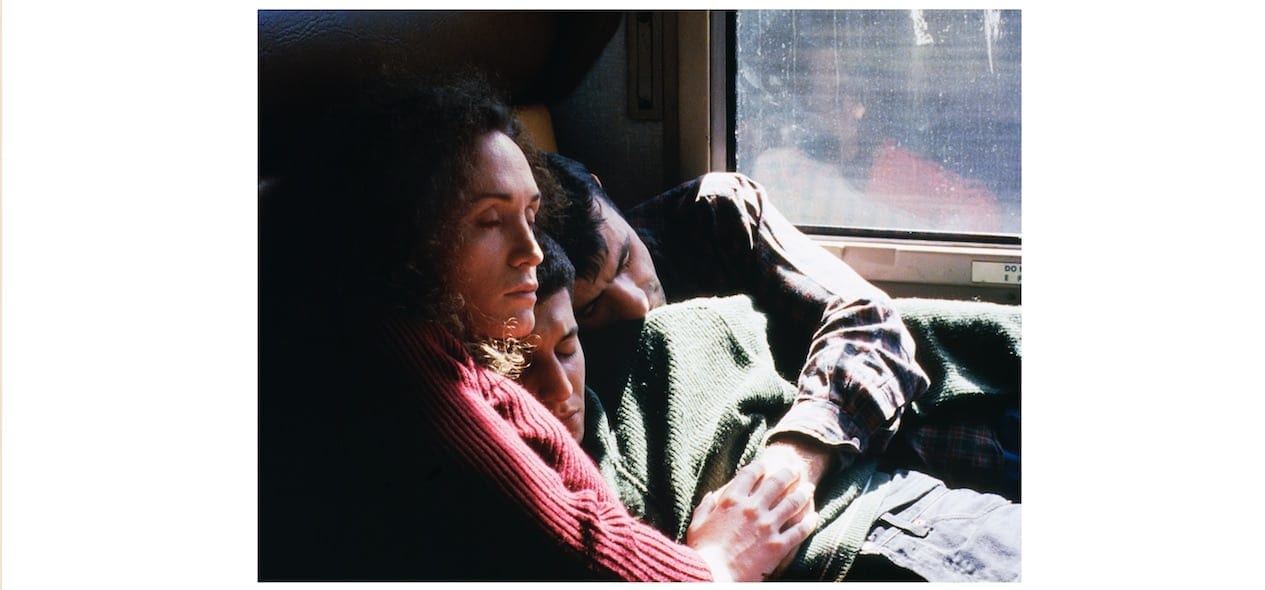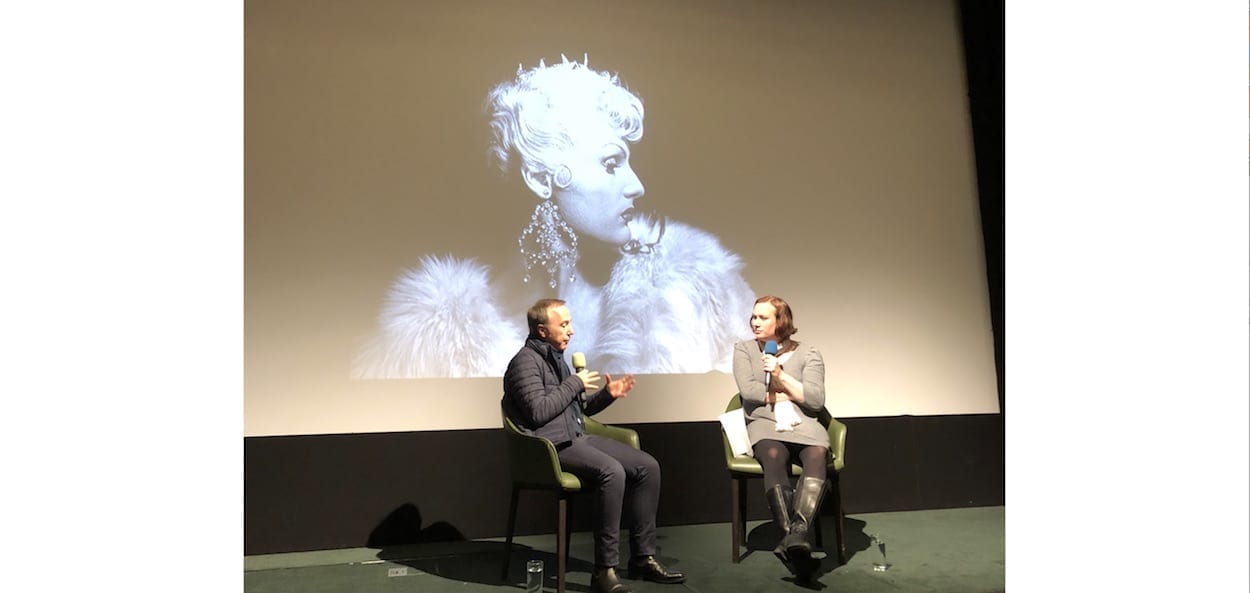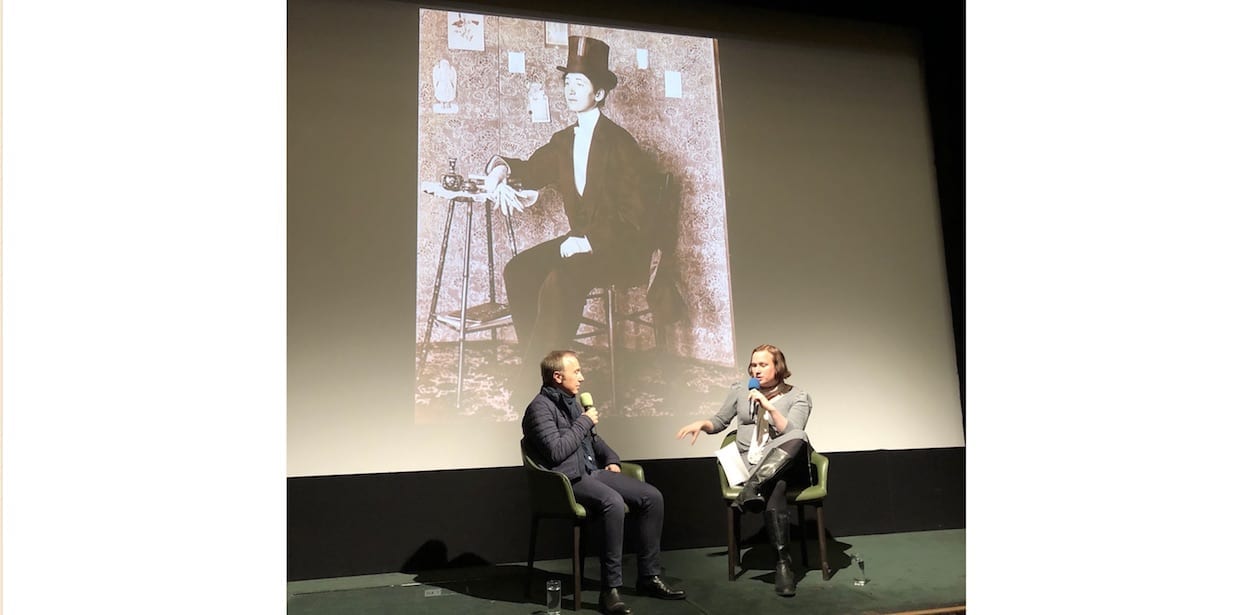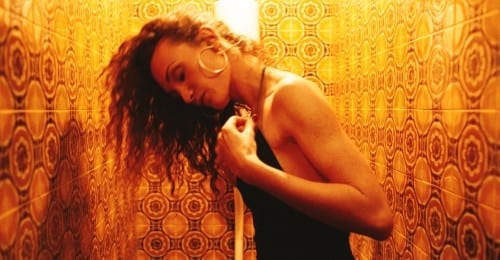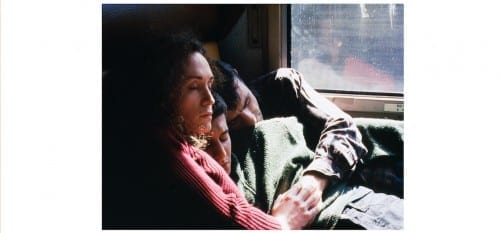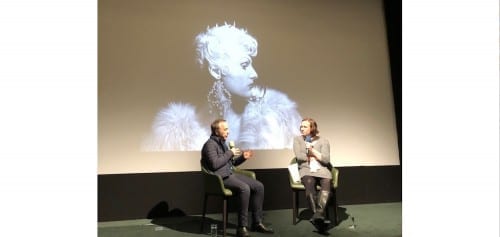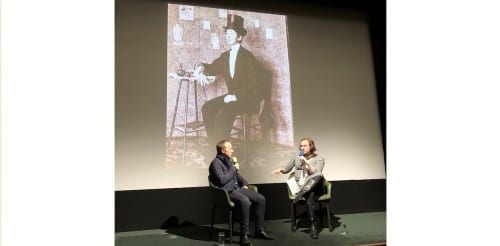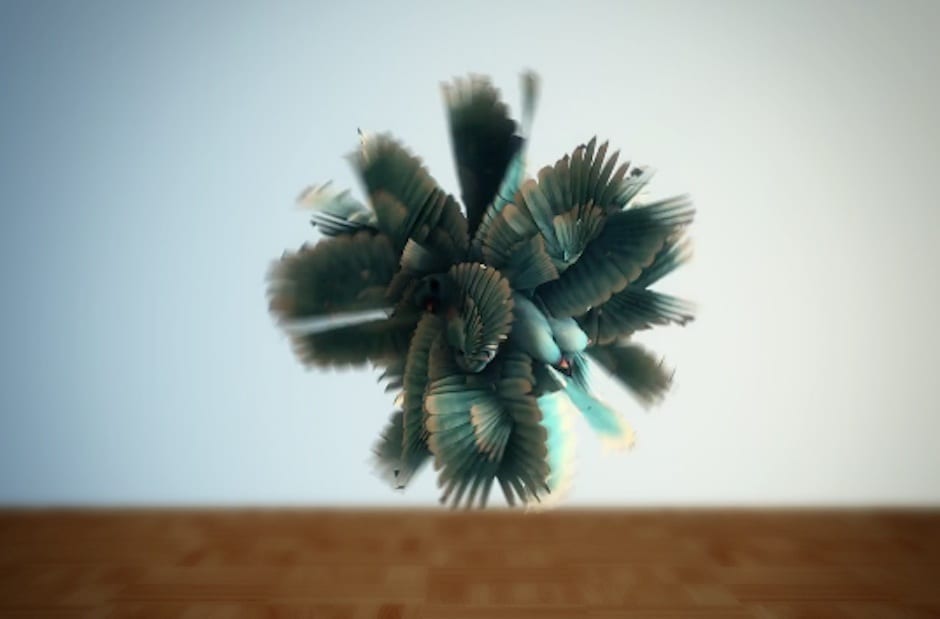Juliet Jacques: Wild Side was one of the very first narrative films I saw with a trans actor playing a trans role. I was 23 years old, I was grasping towards a transgender and ultimately transsexual identity. I was really just starting to identify as trans rather than as a gay man, which was what I was thinking of myself as before. I hadn’t seen many films about trans people. When I had, they hadn’t usually had trans actors playing the protagonists. So [Wild Side] was a film that really did make a strong impression on me.
Sébastien, I wanted to start by asking to you to talk a little bit about how you began collecting photographs of cross-dressers: if that led you to make this film.
Sébastien Lifshitz: When I was a teenager, I was living in Paris. As a Parisian, I used to go to flea markets. I was completely in love with photography and it was very easy at that time to find lost images on the ground that nobody cares [about]. Most of the time, I chose one or two that I found really lovely. I had really no intention. But then after years, the amount of pictures were quite huge and I started to realise that I was doing a collection. Some topics were recurring. My obsession with photography was telling me something about myself.
One of these topics was homosexuality and cross-dressers. I was a teenager looking for myself. I was gay but not yet really into it. I was probably looking for pictures telling me how gay life, gay people were before. I knew that I was not the only one, but it was quite difficult at that time to find pictures of the gay scene, even films with gay characters were not so easy to watch. I was really looking for models for life. So, these kinds of pictures, when I could find them, were little treasures to me. They were and still are very rare, because gay people and cross dressers at the time used to destroy their archive, their private photographs. It was so secret. They had hidden life.
Juliet: Did this long-term interest lead you to make “Wild Side” ? Was there some progression from collecting the photographs to making the film?
Sébastien: Probably. I think it was unclear; it was made more with intuition. The difficulty when I started to write Wild Side, there was no film or documentary about transgender people. Of course, I knew Candy Darling, the movies of Andy Warhol and Paul Morrissey and all the Factory’s people. But it was really underground and so New-Yorkish.
It was quite difficult at that time to convince a producer to do a movie with a transsexual character for the lead role. I remember that my producer, Gilles Sandoz, said to me : “So, you want me to go to Canal + and ask them for money for a story about a transgender woman who is going to the north of France to see her mother dying. Plus, there will be no famous actors, only non-professional actors . Is this a joke or what?”
He thought that it was bold but almost impossible to produce. So I said to him : “I really want to tell this story and I don’t want to make any concessions. I want to mix fiction and documentary into the film so I don’t want real actors.” Anyway, I knew there were no transsexual women actresses in Paris at that time. I had no choice. I had to find an anonymous and non-professional actress for the lead role. My producer was really brave, because that wasn’t so easy to find all the money for such a film but he did it.
What I did first, was to meet the transsexual community. I realised that the transgender scene in Paris was not unified. Everybody was fighting against each other. Points of view were so different. There was a transgender association saying that even the word “transsexual” doesn’t exist. You are a man and then you become a woman, or you are a woman and you become a man. You don’t have to talk about the phase in between, you even don’t have to put a word on it. It was really radical. There were other associations saying that a transsexual could be a man with no operation. His psychic identity is what made him, or made her.
All this was quite something to deal with, because everybody was asking me, “What is your story? Is she going to be a transsexual with an operation or without an operation?” – which was a big thing for certain associations. At the end, I decided to do what I was really interested in: to show a body as Stéphanie with no operation, but with a kind of transformation because the body of Stéphanie is, I would say, half woman half man. For me, it was a way to say transsexuals are not only one thing.
For Stéphanie, for example, when I met her, she said to me that she didn’t want to have an operation. I met a lot of transsexuals that really felt as women, but they really wanted to keep their penis. Of course, I met others that were completely the opposite. But I think that diversity was really interesting and important to put into the film.
Juliet: Can we talk about how you cast Stéphanie Michelini in the lead role and how much she shaped the story? Obviously, the character is called Stéphanie, so they share a name. I’m thinking of some films, like I imagined Rosa von Praunheim, whose trans characters would be trans people playing some version of themselves. I’m thinking even of a recent film like Sebastián Lelio’s Fantastic Woman. I interviewed Lelio about that film recently and he talked very interestingly about coming up with this scenario and then casting Daniela Vega in the lead role. And then how his script was informed by some of Vega’s experiences.
There’re moments in the film when Stéphanie is seeing her mother and her mother uses her kind of dead name and misgenders her. It’s all very sad and very touching. I think for a lot of trans people, those experiences will be quite familiar. I was wondering what Stéphanie Michelini brought to the script and to the role?
Sébastien: I was used to mixing actors and non-professional actors in my other films. I like that because it brings a part of reality, a documentary aspect, into fiction. Anyway, I had no choice, I had to find a non-actress for the lead role. So I went to all the transsexual parties and discos. I met a lot of them and I asked some of them to play one or two scenes from the script, and it was always catastrophic. After months and months, I was a bit scared not to find the one. But one of the directors of casting I was working with said to me, “I may have found someone for you,” and it was Stéphanie.
I met her in a café. When she arrived, I knew at first sight she was the one I was looking for. She was fantastic. She had this very shy voice, she was so discreet, very feminine, with no showing-off. She was extraordinary, really. I didn’t tell her at first what I thought. The first rehearsal was catastrophic again, also with the Russian guy, her partner in the film, who was also a non-actor. The first try was really depressing because they had no technique. They had a kind of fantasy of what it is like to act in a film. They weren’t showing who they were in real life. They were projecting something, a kind of fantasy into their way of acting which was so untrue. Every time, it was fake. But fortunately, little by little, they succeeded in using their real persona for their role.
The script was really written with my invention and Stephanie felt really close to it. Like in the film, she lost her little sister when she was a child. She told me that some of the scenes that I wrote were very close to some moments she had been through. And I remember that Stéphanie, for little details, told me, “No, you can’t ask me to say that,” or, “You can’t ask me to do this.” Some details were a bit too much or not realistic in the script. She was really helpful with that. I changed the name of the character because I wanted her to have the same first [name]. Also, Stéphanie was a prostitute so she knew everything about prostitution. All the situations that you can see in the film are really true. They are not fantasy.
Juliet: There’s something I wanted to ask about how you use voyeurism in the film. We’ve talked directly about the nude shots of Stéphanie. Also there is the scene where the man pays to watch Stéphanie having sex. We see it from his perspective, at least at points. I’d be interested to hear how you’re positioning the audience there.
Sébastien: I chose the full nudity of Stéphanie at the beginning of the film, during the credits, because I didn’t want that nudity to be an event into the film. That’s why I put it right at the beginning; that way, we can move on and voilà !
About the scene with the voyeur, a lot of people with transsexuals want to be in the position of this client. I was just playing with it. Also, the scene is a kind of resumé of the film. The client represents the hostile world, cold and intractable, and Stephanie and Mikhail represent two solitudes, fragile and desperate. It’s raw and dark and obscene, in a way. Then, from that dirt, something is happening – which is probably the most important thing – the two lonely characters are feeling something for each other. It’s a kind of real encounter. Love is appearing under the eyes of darkness.
Juliet: I think this is a really nice moment to go to questions from the audience.
Question 1: I’ve really enjoyed the film. I wanted to know why you made it so dark, though.
Sébastien: It’s not totally dark, there is also the love of this triangle. Probably because of the hostility and difficulty of life that they’ve been through, they succeed to build something all together. These three characters represent a kind of utopia. Together, they have something, even a small thing which helps them to keep on living. But I do recognise that the context, the outside world of these three characters are melancholic and dark.
A lot of transsexuals I met in Paris told me their stories and it was quite something. Maybe today, we’re living in different times – even if it’s still very difficult, I think – because the media really are talking a lot about queer culture. But I remember at the beginning of 2000, it was still difficult to be a transsexual person and a lot of them really were struggling.
Question 2: I thought it was so interesting that Stéphanie in the film, despite being misgendered by her mother and treated with disrespect by other people, is treated with such tenderness and is so cherished by her partners, Mikhail and Djamel. It was so different from the British and the American films I’ve seen with trans characters. I was wondering if you made a deliberate decision to play against those kinds of stereotypes to really show a trans woman being loved and being cherished and being found attractive, because it was very powerful.
Sébastien: The thing is that I didn’t see many films with transsexuals. Very few were existing at that time. When I wrote the script, it was in 2001, so I had almost no references. I wrote it with my intuitions. I remember there was one film of Almodóvar, La Ley Del Deseo – The Law of Desire – with Carmen Maura, who is playing the lead role as a transsexual, but Carmen Maura is a woman in life. Her character was really flamboyant and I love this movie.
Juliet: And there’s a trans actor, I think, playing a cisgender character as well. By the time I saw Wild Side, Almodóvar’s films The Law of Desire and All About My Mother were pretty much the only positive representations of trans women that I’d seen. I’d seen Fassbinder’s film In A Year of 13 Moons, but that terrified the life out of me as a 20-year-old. I really thought, “God, is life gonna turn out like this?”
Sébastien: I didn’t see the Fassbinder movie you’re talking about, at that time. Only the ones I saw were the movies of Warhol and Morrissey, and some with Divine, the John Water’s comedies, that’s it. Now with the digital we think that everything is out and so easy to watch. But in 2000, it was not like that at all.
Juliet: No, absolutely. I did see a lot of the films you were talking about in the 90s, but I had to stay up very late to see them on Channel 4 or BBC2, when if you missed them, or you forgot to set your video recorder, you weren’t going to see them. We’ve got our next question.
Question 3: Did you improvise any of the script, or was it all scripted? Also, you mentioned with the actors you tended to use a certain kind of effect. How did you go about doing that?
Sébastien: Well, there was a script, for sure. But I’ve proposed to the actors the idea to improvise some scenes, every two days during the shooting. I used to do two or three scenes. They knew that something was coming every two days. I asked them to use their character, everything they knew about their character, and to try something with a theme or just a little idea. It was really wonderful to watch them invent something with the character that they were living with. At the end of the shooting, I had a lot of things that were completely improvised. Even the last take of the film, it’s a mix between these very fictional things I wrote combined with this camera-on-the-shoulder and very-close-to-the-characters improvisation.
Juliet: I said earlier, this reminds me of certain works by Rosa von Praunheim, particularly a film from the early 80s called City of Lost Souls, where there’s lots of conversations between trans women on screen. They were largely improvised, and I know this because I tried to interview Rosa von Praunheim about this film for a magazine called Bar Plus One. I was trying to write a 3,000-word feature and I emailed Rosa some questions about how the script was written because I’d never seen anything like it. Rosa answered all of my questions with a single word: Improvised. Which meant my feature was 2,990 words short. So it’s good to hear more about the process.
Question 4: I’m wondering whether you could tell me what was in your mind when you directed that scene of the mix of the English and the French language. It was such a neat little scene in the context of the movie. So what was in your mind?
Sébastien: I did several movies with Yasmine Belmadi, the Arab character – Djamel is his name in the film. I remember that when we did some promotion abroad with him for others films, he had to speak English. It was terrible. It always made me laugh because he was saying words that meant absolutely nothing and I said to myself, “I have to use this.” The Russian actor had also some difficulties with French language. I thought that it could make a good comedy scene to use these two boys in a scene where they have to communicate, even if communication was quite impossible. They had to find a way to say things to each other. I also love the scene when Stéphanie tries to teach French words with her body to Mikhail : “Mouth. Arm. Eye. Hair”. It’s very simple, but really moving.
Question 5: There’s one scene, actually towards the end, where Stéphanie destroys an archive of photographs. Can you tell us a bit about that?
Sébastien: It was difficult because they are real found photographs. They were not mine, for sure. But I remember when I met Bambi [Marie-Pierre Pruvot] for the 2013 documentary film I did about her life, I was looking for the photographs from her period as a boy. I asked her, “I really need these pictures because we need to see the incarnation where you come from, just to understand the whole journey – everything that you’ve been through.” She said to me, “I’ve destroyed everything.” I said, “I’m sure you’re lying.” Bambi just laughed at me and said, “Maybe I have something.” I remember that little by little, I had to deal each photograph. Weeks after weeks, I had one picture, then a second one, then a third one.
With Stéphanie, it has been the same. She didn’t want me to see the pictures of her “before”. The destruction of the pictures of who they were as a boy is something very common. Really, it happens a lot. It’s difficult for me to accept it because it’s a so precious archive, but I understand why they do it.
Juliet: [In] the collection that’s being exhibited at the Photographers’ Gallery, there are occasional photos of fairly well-known cross-dressers, female to male impersonators, trans performers, but a lot of the photographs are of people who are not particularly famous. The photographs are from flea markets or places where you just found them. I think that aesthetic translates over to Wild Side, because this is a film that’s not trying to have a spectacular protagonist. What I really like about Stéphanie and what you said about her as a person and as an actor, is how she’s not striving to be flamboyant or spectacular or anything. Maybe we can talk a bit about the quiet kind of beauty of these anonymous people in portraits and, I think, the quiet kind of beauty of the film?
Sébastien: It’s true. At the Photographers’ Gallery, all the pictures you see are from anonymous people. They’re not supposed to be on walls, visible. All of this archive that I’ve collected is very important because it’s a memory. Today, people think that queer culture is new, it’s something fashionable, but it didn’t appear in a day. Queer culture has always existed, it has a past, a long past. And I think its history is very important to tell.
This is what it’s all about in the show at the Photographers Gallery, with all these very anonymous people, these hidden lives on the walls. These little photographs were probably a secret document for them, something they shared preciously. A kind of an inner picture of them. I love these pictures. There is a story behind each of them. As a filmmaker, I can see a different movie on each photograph, even if I don’t know anything about them. They are so mysterious.
Juliet: The exhibition runs all through May [till June 3], so you’ve still got time to see it at the Photographers’ Gallery if you haven’t had the chance already.
LINKS:
The Photographers Gallery – Under Cover, A secret history of Cross Dressers

